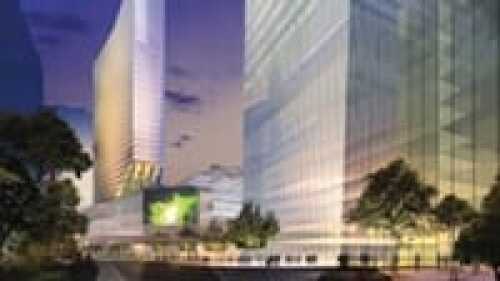Mixed-Use
Hong Kong–based Swire Properties is planning Brickell CitiCentre (BCC), a nine-acre (3.6-ha) mixed-use development in the heart of Miami’s Brickell Financial District. And in May, Genting Malaysia Bhd announced plans to build Resorts World Miami after buying a 13.9-acre (5.6-ha) piece of land. Read how downtown Miami’s fast-growing residential population has made these projects possible.
As the number of U.S. factory jobs continues to shrink, cities increasingly find themselves with underused or abandoned industrial land. Where these sites border residential areas, the result is blight and increased crime. Read how the Oakland, California, housing authority took aging public housing on a blighted site and remade it to strengthen connections to nearby residences and community amenities.
Digital technology revolutionized the way entertainment professionals work, bringing about a convergence of media, entertainment, and technology that allows creative companies to downsize their workspace and locate wherever they please. Read about districts that are attracting entertainment firms with their interesting, edgy architecture and attractive lifestyle amenities and services.
In the age of creativity and innovation, developing “creative clusters” is vital to meeting the challenges of a new, global, knowledge-based economy. Read what visionaries in places like Chicago and Miami are doing to develop jobs-producing creative hubs targeting designers, graphic designers, and others representing one of fastest growth sectors of the new economy, the creative industries.
Parks are increasingly being viewed as fiscal drains that further endanger a mayor’s bottom line. To counter that view comes Alexander Garvin, thinker in the realm of cities and public spaces. Read a review of his book Public Parks: The Key to Livable Communities, in which he presents the rationale for considering public parks as fundamental components of the built environment.
To transform the city’s moribund central business district, municipal officials in Quincy, Massachusetts, are partnering with Street-Works—a development firm that specializes in the creation of mixed-use districts around public spaces. What’s unusual about the Quincy project, however, is that the private sector—rather than the public sector—is doing the heavy lifting upfront. Learn more.
“By integrating one of the oldest buildings in Milpitas within a new, high-density community, the city is able to grow while still maintaining the continuity and historic feel of its city center.” Read about the seniors’ housing project in California—honored in the 2009 ULI Awards for Excellence: The Americas competition—that inspired this description.
Four experts examine the trends affecting urban mixed-use development, including near-term development prospects, the best sources of financing, and the right mix of uses. Read what one considers the biggest game changer, and learn about the impact advances in social/interactive technologies may have on the sector.
The emergence of a new flavor of public/private partnership, sponsored by the Atlanta Housing Authority, has propelled the revitalization of dozens of housing project venues. Those partnerships, unprecedented among housing authorities at the time, have evolved into highly effective development enterprises over almost two decades. Read what caused the angst that triggered the transformation.
Transit-oriented development (TOD) has gained popularity as a sustainable form of urban growth. Creating a mix of mid-rise buildings and activities around a rail station, interlacing the site with pedestrian amenities, is one of the best antidotes to car-dependent sprawl. Read about the new ultra–environmentally friendly version of TOD that is taking form in several global cities.









